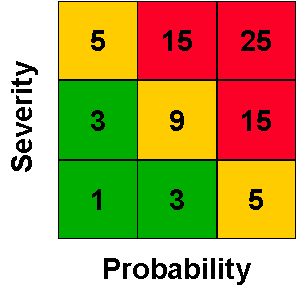Risk assessment
Product development is full of risks and uncertainties, whether technical, market or organisational. Many of these can resolved in the early stages of the project - the fuzzy front end - by searching for information or conducting pilot studies. Others will remain throughout the project as design and development proceeds.
Rather than just crossing fingers and hoping that it will be 'alright on the night', it makes sense to draw up and maintain some form of register of risks, and plan activities to reduce significant risks as quickly as possible.
This simple method can be used to assess and prioritise risks, on the basis of their probability of occurrence and severity of impact on the project.
Method

Draw up a list of potential problems
Make a list of all the 'unknowns' or other issues which could impact the project. This could be done during a team brainstorm session.
Assess probability and impact
For each issue, rate the probability of occurrence and severity of impact as either high ,medium or low.
Derive a risk 'score'
Score 5 for high, 3 for medium and 1 for low. The risk score is then derived by simply multiplying severity x probability . This will produce a number in the range 1 to 25.
Prioritise each issue
Each issue can now be categorised as either red , yellow orgreen . Priority should be given to red 25 s and red 15 s.
Assign responsibility
If the risk is due to absence of information, assign someone to find out. Look out for high risk issues which may occur downstream. What can be done now to reduce that risk?
Continue to update the list on a regular basis
Make sure that positive action is being taken on the major risk items. Add new risks to the list as they become apparent.
For more information, please contact:
T: +44 1223 764830









